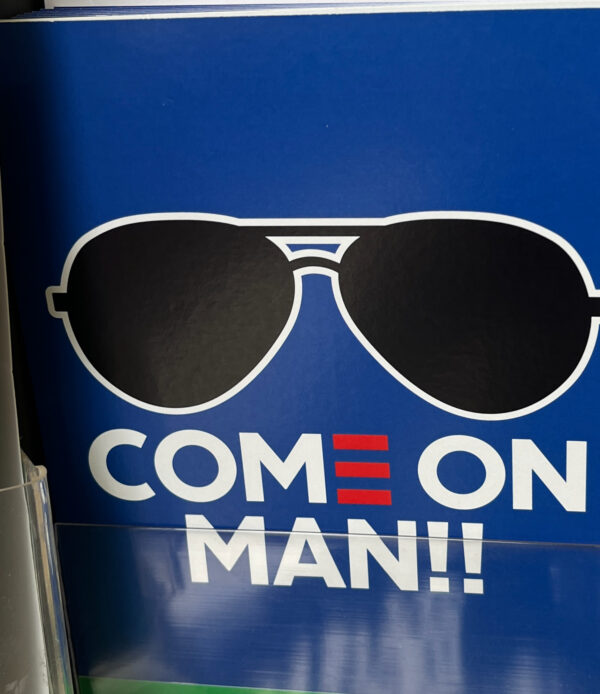I'm Still Better than a Robot
This post went out to subscribers to my Substack newsletter on March 15, 2023. Check out all the posts, including ones from the archives not reposted here, and subscribe here.

My most recently completed article, which won’t be published for a while, is a column for Foreign Policy magazine on Joe Biden’s aviator sunglasses.1 It’s part of a package about specific objects in the news. (One of the others, for instance, is on tanks.) So I decided to check out the new edition of ChatGPT by giving it the assignment: Write a column about Biden's aviator sunglasses in the style of Virginia Postrel.
The result isn’t a bad generic column. It could fill any number of content maws. But it isn’t in the style of Virginia Postrel. Without scooping FP’s publication, it’s safe to say that my actual column is both more substantive—more research was involved—and more interesting. Here’s what the chatbot turned out:
Joe Biden's aviator sunglasses have become a symbol of his presidential style, reflecting not only his personal fashion taste but also his political persona. The aviators are a classic choice for any leader, projecting an image of strength, confidence, and authority. But for Biden, they also convey a sense of authenticity and a connection to a bygone era of American politics.
The aviator sunglasses were first introduced in the 1930s as a functional tool for pilots to reduce glare and protect their eyes during flight. They quickly became popular among military pilots and then civilians, and have since become a timeless style statement. The classic shape features large, teardrop-shaped lenses with a thin metal frame that curves around the ears.
Biden's affinity for aviators dates back to his early political career, when he was known for his classic, preppy style. He has been spotted wearing aviators at various public events over the years, including during his time as Vice President under Barack Obama. But it wasn't until he took office as President in 2021 that the aviators became a staple of his daily attire.
The aviators are a fitting choice for Biden, who has often been praised for his down-to-earth demeanor and his ability to connect with people from all walks of life. They also serve as a nod to his long career in public service, spanning several decades of American history. The sunglasses reflect a sense of nostalgia for a simpler time, when America was seen as a global superpower and the world looked to its leaders for guidance and inspiration.
But the aviators are more than just a fashion statement for Biden. They are a visual reminder of the responsibilities that come with leadership, and the need to remain focused and vigilant at all times. The sunglasses shield his eyes from the harsh glare of the political spotlight, while also conveying a sense of calm and composure under pressure.
In many ways, Biden's aviator sunglasses embody the qualities that have made him such a popular and effective leader. They are timeless, classic, and unassuming, yet also powerful and authoritative. They speak to a sense of American pride and patriotism, while also acknowledging the challenges that lie ahead.
As Biden continues to navigate the complex political landscape of the 21st century, his aviator sunglasses will likely remain a fixture of his public persona. They are a simple yet powerful symbol of his leadership style, reflecting his commitment to duty, honor, and service to his country.
When my article is published, I will link to it.
Assorted Links
This post by Robert Graboyes is great fun and a powerful reminder of the ways in which everyday technologies have changed over the past few decades. It reminded me how, during my college years (1978-82), I used to have to stand in line at the bank whenever I needed cash or, when the bank was closed (i.e., weekends) I’d have to pay the university store a 50 cent fee to cash a $25 check.
Could plastic be the future of road construction? Zach Caceres looks into the possibilities for Works in Progress (which you should all be reading).
When applied to complex systems that rely on local knowledge “design thinking”—surprise!—is, at best, a big waste of time and money. What works for inventing the Swiffer turns out to be pretty dumb about education and health care. Writing in Technology Review, Rebecca Ackerman looks at where the designers went wrong.
Economist David Rose proposes an interesting reform to give voters primary results they’re more likely to find satisfactory: allow them to vote not only for candidates but explicitly against them. Then subtract the negative votes from the total. Along the way, he explains Harold Hotelling’s median voter theorem and why it doesn’t apply in primary fields with lots of candidates. I’d definitely vote for his proposed reform. Read the whole thing.
In one of those “content maw” articles soon to be replaced by ChatGPT, CNBC reports that graphic design topped Upwork’s list of in-demand skills. “This skill is in ‘giant’ demand—and can pay up to $145 an hour as a side hustle” is the headline. This result isn’t what the “robots are taking our jobs” crowd might have thought back when I was writing The Substance of Style. Skills once reserved for trained designers were being embedded in everyday software. But it turns out that just raised the ante—much as TSOS readers might have expected.
Jeff Maurer’s I Might Be Wrong offers a smart take about why liberal kids seem to be more depressed than conservative ones. It's the most plausible explanation I've seen. Plus jokes.